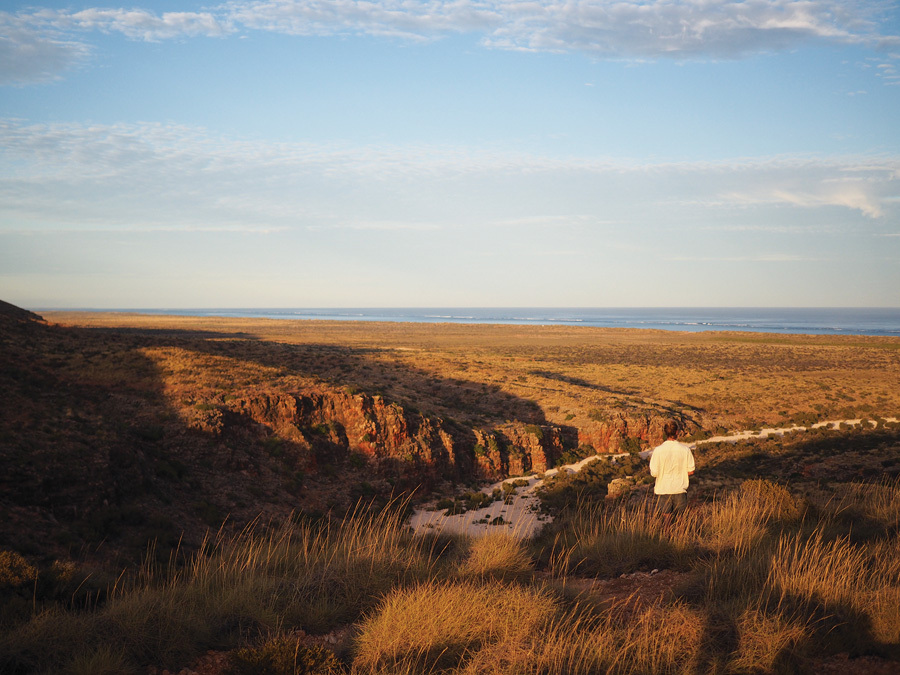Ningaloo Salvation
Reef, desert and sky culminate in a defining Australian landscape.
It is a riveting and, at times, intimidating primal landscape. From high on the Cape Range the vast interior extends behind into the Never Never. And way below Sal Salis, Ningaloo Reef lies nestled in the primary dunes facing the world’s longest fringing reef and the azure Indian Ocean, which extends all the way to Africa.
Arriving at Sal Salis some 1200 kilometres north of Perth our bags are collected at the dusty car park, and as we wander the 800-metre track through the low scrub, we find ourselves immediately in touch with the rhythm of the area. Wallaroos bound out of our way whilst we wait on an echidna to move off the path.
At the bar, there is a remote sense of having just accompanied Lawrence across the endless sands of Arabia as we are greeted with a refreshing strawberry and lime soda.
Sal Salis is fundamentally a learning and inspiring experience in a dynamic and vast landscape, far removed from a poolside vacation. The guides and kitchen staff are the most essential element of the visit. We were soon snorkelling across mushroom and staghorn corals as Damo, an enthusiastic autodidactic guide, led us to white tip reef sharks, manta rays and green turtles. All the while we were surrounded by schools of a plethora of tropical species. The beauty of the Ningaloo reef is that you plunge straight off the beach into an aquarium-like world.
The next morning Damo guided us in pre-dawn gloom along the ancient bed of the Mandu Mandu Gorge. Black-footed rock wallabies can be seen bounding up the sheer limestone walls. The gorge is a microcosm of flora and fauna. Deep within the dark caves remnant troglodytes of the Gondwanaland era eke out an existence in a Gollumlike world. Tucked in the shady nooks Kurrajong trees thrive as they tap deep into the limited water available.
Once back at Sal Salis we kayak across the lagoon and manage to swim through the breakers. Here the reef plunges into the depths. Massed schools emerge from the deep purple and surge into the shallow coral reef. Later staff tell us that there were breaching humpback whales just beyond us but we were so spellbound by the dazzling sights below we missed the migratory show.
The staff are all involved with conservation activities, not only to minimise impact but importantly to contribute to the research of this important World Heritage region. Throughout the turtle nesting season in summer, numbers are recorded and passed on to scientific bodies.
On beaching the kayaks we are treated to a lagoon-side barbecue of squid from Fremantle and snapper from Exmouth, accompanied with pickled watermelon and washed down with sublime sparkling from Margaret River. It is time to seek shelter from the tropical zone and with a Capricorn shimmy we retire to our tent. The structure is simple, with an outside awning over the main canvas. Gentle ocean breezes waft through and send us into a post-prandial dream world.
Recharged we head off to explore the Yardie Creek Gorge by kayak with Alex, a flora and fauna sage and passionate whale lover with a marine biology degree. We journeyed back through the aeons as the westering sun highlighted the stratigraphic ochre limestone.
Tulki, Trealla and Mandu formations mark the different epochs and climatic conditions. Drifting in the serene amphitheatre we were observed from on high by nesting osprey and the ever-present rock wallabies. As we coasted along I posited to Alex whether specific humpbacks that travelled up past Ningaloo had ever been tracked migrating north up Australia’s east coast. Incredibly he informed us that researchers had tracked a group who had travelled up the west coast through the Gulf of Carpentaria and joined their east coast brethren, sharing their unique songs endemic to the west coast humpbacks. Astonishing.
That evening Sal Salis turned it on as a band of cirrocumulus cleared from the west. The dining deck provides an uninterrupted view across the reef and from the early morning guests and staff will congregate to gaze at the show unfolding. We dined on sumptuous local seafood, including lemon myrtle scallops and local snapper as the crimson sky morphed into a planetarium wonder during dessert.
The following day dawned crisp and clear and we were on the move early to meet the Ningaloo Discovery team aboard the 55-foot sailing catamaran, the WindCheetah. After another incredible dive off Tantabiddi to ascertain everyone’s capabilities, we headed beyond the reef in search of the enormous planktondining whale sharks. With the assistance of spotter planes the
Windcheetah manoeuvred to drop us into the path of these cruising giant fish. The first encounter is jaw dropping – if that is possible with mask and snorkel. An eight-metre leviathan with mouth agape is bearing down on us. It’s impossible to scream or flee, stricken helpless with awe as this immense living presence and accompanying acolytes of trevally move past at a funereal pace. It is easy to keep up and the whale shark’s stunning features and huge pectoral and dorsal fins are revealed in amazing clarity.
A visit to Ningaloo Reef is truly a defining moment. It is uplifting to witness the passion of the Sal Salis staff as they immerse themselves in the wonders of this semi-arid landscape facing one of the world’s oceanic phenomena. Their desire to impart knowledge and passion is a highlight just as much as the spectacular location of reef, desert and sky.











